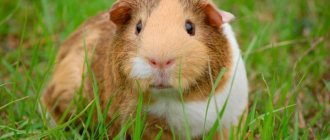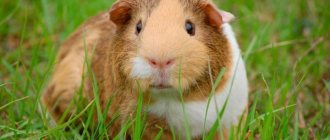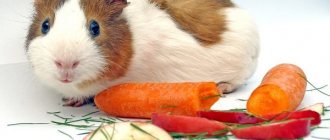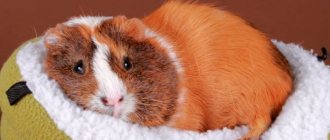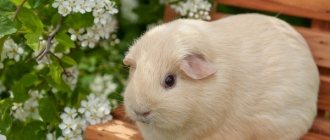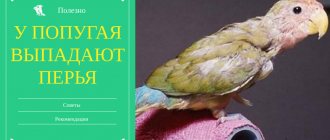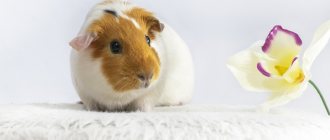The habits of animals can cause confusion among people. Guinea pig owners know this quite well. When they see their guinea pig eating its own poop, they may panic and search for the cause of this strange behavior. Should these actions frighten the owners and what are they connected with? In this article you will find out all the answers to these questions.
Keeping at home
Immediately after acquiring a guinea pig, the pet goes through the process of adaptation to new conditions. Therefore, you should not be surprised if at first the animal behaves very quietly and calmly. Rodents at this time are frightened by any rustle and practically do not move. Also, at the initial stage of adaptation, pets eat very poorly.
Feeding
The animal must eat well; the diet must consist of four meals. One serving is 2 tablespoons. At first, the guinea pig may not eat everything. But this does not mean that the serving size needs to be reduced. Keeping these animals well fed is the key to excellent health.
Guinea pigs eat hay and, in the summer, fresh grass. During pregnancy of the female and feeding of the offspring, feeding is carried out no more than twice a day. Parsley is contraindicated during this period. It is recommended to add vitamin C to water intended for pets if the food does not contain this component.
Products that should be in your pet's diet:
- cucumbers;
- salad;
- beet;
- pears;
- corn;
- pumpkin;
- apples;
- Bell pepper;
- carrot.
Cabbage is best given to animals in limited quantities. Dried rose hips can be added to the food. The leaves of herbal plants can also be used as additives. You can also add table salt to the animal's food in small quantities (up to 2 grams).
It is strictly not recommended to give grains in their pure form to pigs, as this can have a bad effect on health and subsequently lead to obesity in the pet. It is necessary to mix them with vegetables or herbs.
Cage and accessories
One guinea pig can be housed in a small cage; it must be at least one meter long. It is desirable that its rods be painted. It is also necessary to ensure that there is a small door for the animal.
The animals are not able to move in height, so multi-tiered cages are not suitable for keeping guinea pigs. A 0.25 liter drinking bowl and a food container should be placed in the cage. It is recommended to purchase a pet carrier.
Games and training
Such animals are easy to train if you work with them daily. You can accustom a guinea pig to being handled in a short period of time; these animals quickly get used to their owners.
It is best to train animals using various treats. You also need to play with the animals, because guinea pigs live in packs and are easily stressed when alone. Even one training session will be enough to tame it.
Diseases
In order for the animal not to get sick, it is enough to adhere to the basic rules of keeping pets. The most common diseases among guinea pigs are related to the digestive system. Guinea pigs can also be susceptible to colds.
Symptoms of the disease:
- thirst;
- unusual behavior;
- breathing problems;
- cough;
- decline in activity;
- loose stools;
- formation of skin ulcers;
- the animal may begin to shed;
- runny nasal discharge;
- parasites in wool.
Vaccination
After purchasing a guinea pig, it is best to keep it in isolation and not allow it to come into contact with other pets for two weeks. Domesticated rodents usually do not need vaccination. In some cases, you can get vaccinated against bordetellosis. This does not mean that the animal will be protected from this disease. The vaccine will only mitigate the symptoms of the disease. For this reason, many do not resort to this preventive method at all.
Care
It is believed that guinea pigs are not picky about their care. The process will not take much of your time and effort.
- Long-haired guinea pigs need to be brushed at least once a week.
- It is necessary to regularly inspect the animal's body.
- Don't forget to trim your guinea pig's nails. This is done very carefully so as not to injure the pet. You can trim them with a special nail clipper or nail clippers.
- It is recommended to ventilate the room in which the pet is kept from time to time.
- Cleaning is carried out once every 4 days.
- If the wool is heavily soiled, it must be washed with shampoo.
- Your pet should be given anthelmintic medications at least once a month.
Dry food in pig diet
With a dry type of nutrition, pig feed is specially developed and enriched with vitamins and minerals.
Pig farms use dry feed that does not cause fermentation inside the intestines of pigs. Such food is easily digested by the pig’s body, providing a quick gain in live weight. In addition, dry residues and what the herd of pigs feed on in industrial complexes do not sour or spoil.
Eating dry feed saves a lot of time and effort. Pigs eat their food well, washing it down with water. In addition, animal feces with such a diet do not have the characteristic smell of ammonia, and the resulting manure quickly decomposes into organic components, which become an excellent fertilizer.
The basis of the dry diet is combined feed, consisting of cereal grains, cake, bran, and hay. This pig feeding diet is enhanced by special complexes of food additives and nutrients. This allows you to diversify the pigs' diet.
Thus, feeding pigs with dry food should be comprehensive and balanced, since piglets need adequate nutrition at different stages of growth and development.
Prevention
To prevent diarrhea in your guinea pig, follow these simple rules:
- Clean your pet's cage regularly using disinfectant solutions.
- Eliminate foods from your diet that cause diarrhea.
- If you bought a rodent from another person, find out what he fed it.
- Be sure to check the quality of the food you give your animal.
- For prevention, give your animal probiotics.
- Provide the pig with the opportunity to fully walk, as it cannot always remain in a cramped cage.
- Daily food should contain all the vitamins and microelements necessary for the full functioning of the body.
- The room where the cage is located should be well ventilated, but not have drafts.
Despite the fact that guinea pigs are strong and active animals with good immunity, you should not neglect the rules for keeping and caring for small rodents. In favorable conditions, the pet will live eight to ten years and will delight you with its health and playful character.
If the animal gets sick and suffers from an eating disorder, do not delay visiting the veterinarian. Guinea pigs have an intense metabolism and lack of therapy will lead to their death.
When caring for a sick guinea pig, it is important to adhere to the treatment prescribed by your veterinarian. Medicines and veterinary products should only be taken as prescribed by a veterinarian.
Quite often, guinea pig owners make the unforgivable mistake of trying to treat their pet on their own. Perhaps a non-specialist will be able to determine the correct diagnosis of a simple disease based on some signs and select the necessary medications, but the problem is that the slightest overdose of the drug can lead to the death of the animal. At home, it is very difficult to calculate and measure the required dose of medication; this should only be done by a specialist - a veterinarian.
If your guinea pig is sick, the first thing to do is isolate it from other animals by placing it in a separate cage and in another room with dim lights, low noise levels and no drafts.
What to do if there is a rat
If a person suspects that a rat has appeared in the apartment, then he should first of all pay attention to whether there is rat excrement on the floor in the rooms, as well as an unpleasant odor. If fears are confirmed, then do not panic; the following measures should be taken:
- First of all, consult with SES employees and notify the management company about the problem.
- What to do with rats in the basement should be decided by the management company's employees. When deciding to use toxic substances, it is necessary to notify all residents of the house, who will take measures to prevent rodents from entering the apartments.
- In big cities, special means are used to kill rats that mummify the animal. Such an animal does not emit an unpleasant odor after death, thereby not scaring away other individuals. Therefore, the drug is very effective in the fight against rats.
If rats appear in the house, you should immediately begin to destroy them. In this case, you should not panic, you need to act quickly.
When to worry
Unfortunately, a pet's restless behavior is not always caused by positive reasons. There is a certain number of negative factors due to which a rodent behaves as if it were popcorning, these could be:
- blood-sucking insects;
- worms;
- dental problems.
Parasites
If an animal gets parasites, it begins to itch and chew its fur. This occurs because harmful organisms cause severe itching in different parts of the pig's body.
They can be divided into two main types:
- worms;
- skin insects.
If you identify one of these problems, you should definitely contact your veterinarian and take immediate action to combat them.
Helminthiasis
When a rodent is affected by this disease, not only itching and restless behavior are externally manifested. The animal is losing weight sharply, dark spots are visible in its secretions
Therefore, when cleaning the cage, it is necessary to pay attention to the feces of the fluffy. If eggs or small bugs appear there, you should start taking special medications, but this should be done after consultation with a specialist
Experienced breeders advise giving pets preventive medications that kittens are usually given, such as Dirofen, Prazicide, Stronghold.
Lice eaters, ticks and fleas
Blood-sucking parasites and lice eaters infect the rodent's fur coat. They cause very strong irritation throughout the animal's body.
Pig constantly:
- itches;
- bites himself;
- rubs against the bars of the cage;
- shakes.
Bald patches appear on the fur, redness and scratches are visible on the skin.
Important! In order to pick up parasites, you don’t have to walk on the street; they can appear due to poor-quality bedding or food that was not washed properly. Harmful insects that attack the fur of guinea pigs:
Harmful insects that attack the fur of guinea pigs:
- Ticks. There are fur, ear, tricacaria, sarcoptic and demodectic. It manifests itself according to all the signs listed above. It is strictly forbidden to treat your pet yourself; you must immediately contact a veterinarian, self-medication can lead to negative consequences.
- Fleas. Fluffies are affected by the feline representatives of this insect - Ctenocephalides felis. Their size does not exceed 5 mm, they can be transmitted through various carriers, including humans. These pests can be identified and removed by constantly brushing your pet with a special comb.
- Vlaseaters. These insects can cause a disease called trichodectosis, which leads to debilitation and death. Parasites stick to the hair of the fur coat, feeding on blood and the top layer of skin. They can be detected upon careful examination; these are small light-colored worms up to 3 mm long. They are also found by laying eggs, of which there can be more than a hundred. They are dealt with using special ointments or sprays based on permethrin. But before doing this, you should consult a specialist.
Dental diseases
If an animal constantly bites the bars of its cage, chews on a feeder or any other dense object, it means it has problems with its teeth. In their natural habitat, these rodents subject their incisors to constant stress, which wears them down. It is clear that at home they have no problems with chewing food, so the teeth grow to the point that they begin to interfere with your pet. But this may not be the only problem. It happens that a pig has bite problems at the genetic level, that is, inherited.
Did you know? Guinea pigs not only grunt, they are capable of making a wide range of sounds, chirping and even purring.
If such symptoms occur, the best solution for the furry owner would be to contact a veterinary clinic, where the cause of concern can be determined more accurately.
If your pet starts running around his home, there is nothing to worry about. The main thing for a beginner in caring for rodents is to determine why the animal suddenly started jumping and eating popcorn.
The pig is eating its litter, Nightmare.
The pig is eating its litter, Nightmare. ¶
From: dinozavr - November 11, 2004 9:41 pm
:confused: Piglet has only been living with me for a month, and I noticed that when he sits in my arms, he sometimes curls up and then starts chewing something, then I realized that this is how he seems to eat his poop. What to do?? Is this normal or should I see a doctor with him?
The pig is eating its litter, Nightmare. ¶
From: Mr. Wolf - November 11, 2004 9:46 pm
This is completely normal. Pigs are corpophagous. Those. maintain the balance of beneficial bacteria in the stomach by eating their droppings. And there is nothing terrible about it.
The pig is eating its litter, Nightmare. ¶
It's even useful! Someone from the forum recently asked to give him a pig litter for his sick pig, as the doctor advised.
The pig is eating its litter, Nightmare. ¶
From: Svetik - November 12, 2004 2:33
It's not just useful! This is vital, otherwise your pig's intestines will stop working and she will get sick and die. This phenomenon is called “coprophagia” and it is natural for pigs. Moreover, they eat “these things” from each other too. And especially babies with their mothers. Now, if they WILL NOT do this, it’s a NIGHTMARE. and then immediately go to the vet.
The pig is eating its litter, Nightmare. ¶
From: Mika_login - November 12, 2004 7:31 am
And my dog also eats up the pig, and with such greed. Sometimes he pushes her under the butt with his nose, “Come on, hurry up!” I wonder what process the dog supports in its body? laughter
The pig is eating its litter, Nightmare. ¶
From: Felix - November 13, 2004 10:20 am
Mechanical wounds
Tissue damage in pigs is treated with antiseptic treatment.
Before starting treatment, you need to clean the wound from dirt and hair and rinse the tissue.
To wash wounds, it is better to use a solution of potassium permanganate in a ratio of 1:1000.
Or you can use a 3% hydrogen peroxide solution.
After drying, the wound is lubricated with disinfectant ointment. Prednisolone or streptocidal ointment are suitable as such an ointment.
The wound is treated daily. Instead of ointment, you can use a bandage with streptocide.
In addition to these diseases, guinea pigs often have:
- conjunctivitis;
- ectoparasites that negatively affect the condition of the animal’s fur and skin;
- parasites - they are destroyers of internal organs - salmonellosis, tympany, trichomoniasis, fascioliasis, cystitis;
- Otitis externa - the ear canal becomes inflamed.
If you become ill, take your guinea pig to a veterinarian immediately.
Before visiting the doctor, sketch out your animal’s “hospital chart”:
- year and place of purchase of the pig;
- conditions of detention (cage, room temperature, humidity, what is included in the diet, mineral supplements and vitamins);
- the period of appearance of the first signs of the disease;
- previous mumps diseases.
How often should you wash your pig?
Pet owners determine the frequency of bath days individually. One animal requires regular washing, while the other successfully lives without it.
A bath for a pig is a necessary measure. You can reduce the number of baths to a minimum if the cause and/or source of pollution is promptly eliminated.
The reason for washing may be:
- unpleasant odor from wool;
- contamination with feces and urine;
- upcoming exhibition event;
- ending the treatment of diseases of the coat and skin if ointments and products with a strong odor were used.
If the animal's fur is stained with the juice of grass, berries, fruits, vegetables, then such contamination can be wiped off with a damp cloth. The pet eats every day, but this does not mean that it needs to be washed every day.
There are situations when bathing is deadly for an animal
and it is better to refuse it. Rodents should not be washed:
- in the first days after the appearance of the house;
- during the period of expectation of offspring;
- if the animal is unwell;
- very young rodents.
There is no point in forcing the process and washing the pig at any cost if the animal actively protests and is loudly indignant. In this case, it is better to postpone the procedure. Nervous stress is much more dangerous for an animal than dirty fur.
In these cases, it is better to use wet wipes. In addition, proper maintenance in spacious cages with regular changes of filler will help keep the animal's coat clean and well-groomed. And pigs can wash themselves using their tongue and paws.
Factors that provoke diarrhea
Diarrhea can occur from intestinal disorders or is a concomitant symptom of the disease. Diarrhea in a pet can be a result of:
- bacterial infection;
- the presence of worms;
- dental pathologies;
- fungal infections;
- nervous stress;
- colds;
- dysbacteriosis;
- consumption of poor-quality drink and food.
It should be noted that even diarrhea that occurs after eating spoiled food can be fatal. The dehydration that accompanies this disorder poses a great danger to the guinea pig. Therefore, it is necessary to show the animal to a veterinarian immediately.
Sometimes pet owners experience anxiety and panic without reason when the consistency of excrement changes. Normal stool looks like hard granules. If it is soft and unformed, this is not necessarily a sign of disease. This may be a consequence of eating juicy foods that soften the stool. But if diarrhea and mucus appear, you need to take action immediately.
Squeals and whines/moans
The friendly animal does not tolerate loneliness well. A pet that has been alone for a long time may squeal loudly when its owner appears. In this way, the guinea pig talks and communicates. Therefore, it is recommended to keep pigs in pairs.
Let's be friends! Well, why don't you answer?
When there is severe pain or danger is approaching, the animal may scream shrilly and heart-rendingly. This pet behavior cannot be ignored. You definitely need to check his health or find out what the rodent was afraid of.
A pig experiencing severe pain may moan and whine. The breeder may notice that the pet yells when a family member or relative appears, as well as when performing some actions. The source of the animal's irritation must be eliminated.
In rare cases, squeals mean that the pet is happy.
What are the signs of the disorder?
Each guinea pig experiences gastrointestinal distress differently, each individually. But there are signs that immediately appear:
- heart rate increases;
- loss of appetite;
- lethargy of the rodent;
- the pig is breathing heavily;
- hides in the corner of the cage;
- I don’t like it when my tummy is stroked;
- often the animal shudders;
- fetid specific odor;
- the anus is contaminated with liquid feces;
- tousled fur;
- If the owner picks up the rodent and listens, he will hear a characteristic rumbling sound.
When a guinea pig has diarrhea, you can feel rumbling in the rodent's stomach.
The most dangerous manifestation of diarrhea is due to infectious plague infection, salmonellosis. Therefore, a visit to the veterinarian is the best solution to rule out possible diseases that could lead to the death of the animal.
Additional symptoms of diarrhea
Regardless of the reason why your guinea pig's bowel movements are abnormal, in addition to diarrhea, it may also exhibit other negative signs. During diarrhea you may:
- lack of appetite;
- heart rate increases;
- difficulty breathing;
- temperature rise;
- blood appears in the stool.
The pet becomes apathetic and shows no activity. There are signs by which you can recognize diarrhea in advance. Before the appearance of loose stools, the excrement begins to smell strongly and foam appears in it. The consistency of the feces is softer than usual; it sticks to the animal’s fur. During diarrhea, the animal experiences pain. The pig won't let you touch his tummy. If you pick it up, you can hear a rumbling sound caused by fermentation and gas formation.
Diarrhea is dangerous not only due to dehydration. The functioning of the entire body is disrupted. Prolonged diarrhea causes disruptions in the functions of the cardiovascular and respiratory systems. Serious complications and death of the animal cannot be ruled out.
If unformed excrement appears that is not associated with the consumption of succulent food, you need to take your pet to a veterinary hospital. The reason for an urgent trip to the veterinary hospital is blood in the stool. It indicates internal bleeding caused by injury or tumor. You should not make a diagnosis yourself. The cause of existing violations must be determined by a specialist.
Diagnostics
Diagnosing such a disease will not be difficult. If you notice liquid, watery stool instead of the usual semi-dry, dense balls, this is diarrhea.
In this case, as a rule, the animal’s feces remain on its fur. If the stool is soft but shaped, it may not be diarrhea. Such feces can be found in pigs that eat a lot of juicy food and vegetables. In any case, if such symptoms are detected, it is best to immediately consult a specialist, because often diarrhea in a guinea pig indicates the presence of some more serious disease. Being at home, without special training, it is quite difficult to diagnose what exactly is happening to your pet, much less prescribe the correct treatment.
Nutrition correction
To speed up the treatment of diarrhea, you need to make adjustments to the guinea pig's diet. Products that cause active fermentation are excluded from the usual menu. During treatment, there is no need to feed the animal bread and crackers. Store-bought products include sugar and starch, therefore they are a favorable factor for the development of pathogenic microorganisms in the intestines. You should not give juicy foods, cucumbers and salads; you need to replace them with hay, hard vegetables, and grains. Legumes should be avoided.
If you refuse to eat, try feeding your pet through a syringe by preparing a creamy mixture.
After recovery, introduce vegetables into the menu in small doses. If diarrhea recurs, be sure to have your stool tested.
Soft bag
Fabric carriers have been around for a long time, but their modern development has primarily affected the increase in the number of all kinds of windows, mesh and other little things. The cat will no longer sit in a dark bag, not much different from an ordinary travel bag. It is difficult to organize a comfortable long trip in such a device. But for short distances the convenience is quite adequate.
The advantage of a soft cage is its lightness, compactness, and the ability to securely attach it to a car seat or, for example, to the handle of a suitcase.
Negatives: Not hygienic for long trips and difficult to clean quickly (although they can withstand washing in a regular washing machine).
Cost – 1,360 – 1,489 rubles.
Other reasons
In some cases, a furry rodent twitches and jumps for completely different reasons. To determine them, the owner should remember events related to the pet that could please him. The animal can rejoice at the received treat or fresh tasty grass. If he has recently been walked outdoors, this may also cause unusual behavior.
It may have to do with the conditions in which the animal is kept. A rodent cannot warm up if it is in a cramped room. He needs more space to play. Due to the lack of active movements, the pet lies on its side and twitches. To change the situation, a caring owner must increase the space by adding toys, wheels and tunnels.
Electric models
Beginners should pay attention to more innovative gadgets. They are definitely a little more expensive
But in this case, the price increase proportionally affects safety.
We are talking about a family of rechargeable machines equipped with a rotating head. They do not cut, but grind down the cornea. With this approach, it is almost impossible to harm a dog or cat by catching too much of a nail. The high rotation speed of the tip ensures fast operation, and the low noise level does not bother four-legged patients at all. Any beginner can easily cope with such a mechanism.
Price – 481 – 1,859 rubles.
Some models are equipped with 2-3 heads, suitable for dogs or cats of various breeds and age groups.
After all, the claws of a dwarf poodle are much more delicate than those of a German shepherd. The same applies to young kittens and adult cats - their paws need to be treated with different elements. So, when purchasing a tool for trimming claws, you should consider this nuance.
Cost – 567 – 1,189 rubles.
The final touch is the rotation speed of the device head.
It directly affects the quality of claw grinding. After all, it is necessary not only to cut off the ends, but also to polish the ends so that the sharp edges do not injure the delicate pads of the paws. This operation is best done in a more gentle mode at low speeds. So a machine with gear shifting will come in very handy in this case.
Price – 497 – 1,566 rubles.
I like it I don't like it
Other fun facts about pigs
Every owner can tell a lot of interesting facts about their pet. And for those who are just planning to purchase guinea pigs, sellers like to communicate the following nuances:
- a pregnant female can “cancel” her birth - the cubs will dissolve inside her, or they will be “preserved” for several years;
- domestic guinea pigs do not like water and do not swim;
- a fall is very dangerous for a pet; it can easily be seriously injured and even die;
- There are hairless rodents - even allergy sufferers can have them;
- The length of the coat in some breeds reaches 50 cm.
Amazing facts about these unusual animals generate a feeling of sympathy even when meeting them in absentia. Therefore, the demand for such cute pets in pet stores remains consistently high in many countries around the world.
What do guinea pigs get sick of?
Like other living beings, pigs suffer not only from pathologies of organs and systems, but are also susceptible to infectious, viral and fungal diseases. Like all rodents, they are carriers of diseases dangerous to human health, namely: rabies, lichen, scabies, salmonellosis, tuberculosis and others.
Therefore, careful attention to your pet, timely detection of the disease and initiation of treatment will preserve not only his health, but also your own.
However, unlike other mammals, guinea pigs have a number of anatomical features and a fast metabolism, so the development of many diseases occurs at lightning speed and can lead to the rapid death of the animal.
Considering all this, the treatment of diseases in guinea pigs should only be carried out by a veterinarian - ratologist, who knows these features well and has experience in this matter.
Feeding
There is a theory - if a rodent has problems with the digestive tract, then it should be fed the feces of another healthy guinea pig. This is actually a myth. It is better to treat the animal only with medications.
Watering can harm the animal. This is due to the fact that all pigs have different internal microflora. It is difficult to talk at all about the health of another pig, since diseases may not have clear signs, and this cannot be determined without laboratory analysis. In addition, only liquid feces are useful, which the pig immediately eats, so it will not be possible to get it.
If you do not want harm to your pet, try to avoid this method in order to cure it.
Tama the Cat: Train Station Master
This happened in the early 2000s, when the unprofitable Kishi station in the Japanese city of Kinokawa was almost closed due to unprofitability. Residents, of course, protested, but it is unlikely that their efforts would ultimately be crowned with success. The situation was saved by a local cat named Tama, who loved to bask in the sun near the train station. The station manager noticed how enthusiastically passengers reacted to this couch potato and gave him the official position of caretaker. The cat was given a uniform cap, a badge and a monthly salary in the form of free food.
The duties of the newly minted minister included advertising functions. He greeted passengers, allowed himself to be petted, and was always somewhere on the platform. It must be said that this policy very quickly led to commercial success. Tourists began to come to Kishi station just to look at the railway cat and take pictures with him. From that moment on, there was no further talk about closing the station.
But the unusual cat's career did not end there. In 2008, Tama became a supervisor and was charged with monitoring the performance of professional duties by staff. That same year, the cat was knighted. Another year later, according to the project of the famous designer Eiji Mituku, the railway included in the schedule a train dedicated to the legendary animal. The carriages were painted with views of Tama, the locomotive was decorated with his muzzle, and meowing signaled the opening (closing) of the doors. But this did not become the crown of the cat’s career.
A year later, Tamu was appointed third party of the railway company, entrusted with the post of executive director. By his old age, it was already difficult for him to work every day, and the management allowed the elderly cat to come to work 3 days a week.
Tama died at the ripe old age of 14. But even after this, the career did not end. Posthumously, the cat was elevated to the rank of Eternal Station Master, thus perpetuating his memory. After all, over the years of work, this four-legged employee has brought considerable income to his company. The tourist flow through the station increased to 300 thousand people annually, and the financial indicator amounted to more than 1.1 billion Japanese yen.
The company's management did not want to accept the loss of such a profitable and already promoted advertising brand. Tama was replaced by Nitama (the second Tama). True, later with the third cat there was an overlay. He was found at Okayama Station and offered a position in Kishi. But the owner did not agree to the move. Next came Yontama (the fourth Tama), who had already had to undergo a special training course before taking her place on the platform of the railway station.
And the flow of tourists wanting to take a photo with the legendary heirs of the first Tama still does not dry out.
I like2I don't like
How to summon the spirit of a deceased relative?
Magic has always made it possible to penetrate into another world, summon the spirit of any deceased person and talk to him. But before the ritual you should think about the consequences
. Spirits don't always want to be disturbed.
It is better not to conduct such a dangerous ceremony yourself. You should trust a trusted medium in this matter. Only he can summon the necessary spirit. It is better to conduct spiritualistic seances in a relaxed state, with good thoughts.
You can summon the spirit yourself or seek help from a medium
Alternatively, you can use a Ouija board. Some tips to help summon the spirit of a deceased relative:
- Relax, throw away all your problems and worries, free your mind
- Don't be afraid. If the session is carried out incorrectly, an evil spirit will come. He will feed on your fears
- Before the session, fumigate the entire room with incense.
- It is advisable not to eat or drink anything on the day of the ritual, do not drink alcohol for 3 days
- call the spirit at night - after 12 and before 14 o'clock
- place wax candles in the room
- thread a black thread through a needle and make something like a pendulum
- on a piece of paper write down all the questions that you would like to ask the deceased
- call the name of the deceased and call to come
- if the needle begins to move, it means the spirit of the deceased is nearby. You can leave the window open, this will make it easier for the soul to get into the room
- If everything worked out for you and you received the answers, then do not forget to thank the spirit for coming and tell him that you are letting him go back
Pathology or normal phenomenon?
Most researchers are inclined to believe that this pattern of behavior is the natural norm for this group of animals. In the process of eating food, some vitamins are not absorbed by the animal’s body.
But as compensation, processes such as:
- food is processed in the stomach using gastric juice;
- bacteria help reproduce essential microelements;
- removal from the body of the substrate, which the pig eats, obtaining the missing substances naturally.
First, the pig eats grass and other foods rich in fiber. Then a number of microorganisms contained in the intestines come into play. It is thanks to their work that the very feces appear that are suitable for eating by animals.
Research has not fully established its true benefits, but what is certain is that this type of feces is very rich in proteins. Despite the not very pleasant fact, the process of eating food in animals leads to the replenishment of a whole complex of nutrients naturally.
In addition, the absorption of natural waste helps the guinea pig improve the functioning of the gastrointestinal tract, which by nature is poorly developed. Some people watch this process with disgust. But for animals it is quite natural.
With the help of the microflora of the cecum, a guinea pig can compensate for the lack of nutrients such as:
- vitamin B category;
- enzymes;
- vitamin K and a number of amino acids.
During the first meal, due to the individual characteristics of the body, the elements are not fully absorbed and the pig replenishes them using the previously mentioned method, which is not the most pleasant for humans.
The process includes 3 steps:
- First, the animal receives foods rich in fiber. The pet needs it, but it does not have time to be completely digested in one go;
- in the process of passing through the gastrointestinal tract, food is influenced by a number of bacteria, converting it into nutritional amino acids;
- After the products come out, the second stage of more thorough assimilation of useful elements begins.
It is with this lifestyle that the intestines and the general gastrointestinal system of the animal will function in the rhythm intended by nature.
This feature is characteristic of many representatives of the animal world. Many owners mistakenly believe that their pet eats droppings only out of stupidity or illness. In fact, animals are quite smart and know what is suitable for food and when. The owner’s task includes competent formation of the diet and timely provision of the animal with the necessary microelements. An important point is to adhere to a special diet; you should not overeat. With a varied and high-quality diet, the pet will receive all the necessary vitamins. It is in this case that the pet will remain active and healthy for quite a long time.
This phenomenon in animal behavior can often be found and not only in rodents. And even in ordinary dogs. Most often, in this way the animal seeks to compensate for the natural lack of any vitamins. For example, a number of monkeys in one of the African countries also ate their excrement. There is another variant of behavior among the young of this type of animal. It is clearly visible in the behavior of elephants, when cubs literally stick their trunks into their mother’s anus to extract nutrients. Despite this unpleasant feature, this behavior helps younger generations acquire high-quality microflora of the gastrointestinal tract, as well as create conditions for eating various types of plants.
As mentioned above, this type of animal includes rodents, such as rabbits or chinchillas. Their structure of the gastrointestinal tract system also does not immediately process food to the desired consistency. Due to the fact that a number of nutrients are not immediately absorbed by the intestinal microflora, the body needs more time to process them naturally. Rodents have a natural ability to compensate for the deficiency by repeatedly eating plant foods.
Why do pigs eat their own droppings?
You can often notice how the pig seems to curl up into a ball, pushing its head under its tummy, and then actively chewing something. Don't be scared, guinea pigs are caprophagous - they eat their own droppings. The flora of the pig's cecum produces the enzymes it needs, vitamins B and K, and amino acids that are not synthesized directly in the body or do not come directly from food. As herbivores, when processing incoming food, they are capable of squeezing the maximum out of it, even if this food is not super-vitamin-rich. The pig passes food through the body twice: first, by eating grass/hay and other foods rich in fiber, which are partially digested, while whole colonies of microorganisms work hard in the intestines, which help convert the consumed plant food into the necessary amino acids, and then, eating “night feces” "(underdigested and especially rich in proteins). Therefore, caprophagia, along with incoming food, provides the pig with all the necessary substances and normalizes intestinal function.
Pigs have two types of feces. The first, ordinary one, containing fiber, grass, etc., we see scattered around the cage and shaped in the form of the usual cylinders. And the second, “vitamin”, is formed differently: it is more liquid, and the pig “catches” it directly from the anus, leaning towards it. The inability to eat such feces leads to decreased fiber digestion, increased mineral excretion and weight loss. (Cheeke, 1987; Ebino, 1993)
There is an opinion that if you have digestive problems, you need to drink feces from a healthy pig.
Digestive problems are treated exclusively with drugs , and not with “traditional poop medicine”. About drinking litter - this is outdated information, nothing more than a myth made up by someone. Feeding droppings from a healthy (?) pig is not necessary and can even be dangerous, since different pigs have different microflora (one microflora may be such that another will simply cause diarrhea (if it was not him who was previously treated, but, say, bloating or constipation, and if there is diarrhea, it will aggravate the situation). And in order to know for sure whether the pig from whom the poop was taken is healthy, its droppings must be tested. Diarrhea is not a disease, but a consequence. And it is necessary to establish for began the cause. There are many of them: internal parasites, intestinal yeast, poisoning, intoxication after taking antibiotics, dental problems, feeding errors, coccidosis, etc. Moreover, pigs do not eat feces that are offered to be fed under any circumstances. They are used for digestion you need a special “night" stool, which is eaten directly from the anus, rich in amino acids and vitamins. That is, in principle, it cannot be obtained for this very procedure. And drinking ordinary poop - completely digested food - will do no good + can cause even more harm .
Expert opinion
Experts say that guinea pigs periodically eat their droppings to restore their intestinal microflora, just like other herbivores. This phenomenon is called coprophagy, it is considered completely normal and physiologically necessary for life, so there is no need to prohibit animals from doing this.
Zoologists claim that the microflora of the guinea pig’s cecum synthesizes substances necessary for the body:
- enzymes; B vitamins; amino acids; vitamins K.
At the first meal, these microelements are not absorbed in the body, so animals eat their feces and reabsorb the substances they contain.
Juicy plant products
The category of such food products includes vegetables and fruits.
The diet should include mainly vegetables; fruit pulp is just a treat for guinea pigs. You should not give your pet too much fruit. Their pulp is saturated with sugars, which in excess are harmful to the body of a small animal. From time to time, the guinea pig is allowed to treat a small amount of cherries, apples, peaches, nectarines, apricots, pears, bananas. The rodent enjoys eating vegetables and berries:
- carrots;
- white and cauliflower;
- zucchini;
- tomatoes;
- bell pepper;
- cucumber;
- corn;
- pumpkin;
- celery;
- seedless grapes;
- green peas.
It is useful to treat the animal once a week with berries rich in ascorbic acid: strawberries, currants, raspberries, wild strawberries. You can also periodically offer the animal leaves and twigs of cherries, blueberries, raspberries, gooseberries, and mint.
Eggplants and green tomatoes should not be included in the diet; these vegetables contain solanine, a toxic compound also present in green potatoes. It is strictly forbidden to give your pet leeks, onions and green onions. Bulb crops are poisonous to rodents.
Many owners are interested in whether it is possible to treat a guinea pig with melon and watermelon. The animal willingly feasts on such a treat and even eats watermelon rinds with pleasure. But you need to keep in mind that melon and watermelon are very sweet products, so you shouldn’t include them often in your diet.
You can diversify your pet's menu with fresh peas, soybeans, lentils, and green beans. It is useful to give your rodent juicy pea pods, rich in vitamins and nutrients.
Pigs on a ship - lucky?
With the development of navigation, pigs, living up to their name, began to travel on ships. They were used as food. This was convenient in many ways.
Animals were brought to Europe on ships. These unpretentious compact animals did not take up much space, did not require special care, were flexible, but had excellent meat.
In addition, they got along well with the permanent inhabitants of the holds - rats (relatives, after all), and in times of danger they made sharp and piercing sounds, warning the crew about a possible shipwreck.
In a word, comfortable and profitable “passengers” from all sides.
Longhair
Shaggy breeds have thick, long fur and are in great demand among lovers of fluffy decorative rodents. They were bred artificially and subjected to strict selective selection.
Breeds whose standard officially includes a pure white color include the Peruvian (Angora) and Abyssinian guinea pig, Merino, Sheltie, Coronet, Texel and alpaca.
Abyssinian
This is the most interesting and most recognizable breed. The Abyssinian guinea pig has one very striking distinctive feature that immediately sets it apart from other varieties.
The Abyssinian coat must have so-called rosettes. They are a kind of funnels and appeared as a result of a genetic mutation.
Each Abyssinian guinea pig has about 6-10 rosettes on its body. They are located throughout the body and are absent only on the head and belly of the animal. Occasionally, the Abyssinian guinea pig has so-called “double rosettes.”
Their maximum number can reach 30 pieces. The animal's long fur can be painted in almost any color, including white.
Alpaca
Alpaca guinea pigs are covered with long, curly hair, the structure of which is more reminiscent of sheep's fleece. It grows from the tail to the head and forms a pair of rosettes on the rump and one on the crown. Representatives of the alpaca breed have coarser hair on their faces.
The color of the animals can be almost any color, including white. Occasionally among alpaca guinea pigs there are two- or three-colored individuals.
Coronet
The Coronet guinea pig has very long hair that flows down the sides and does not cover the face. There is a single rosette on the animal's head.
The coronet guinea pig comes in a variety of colors. It can be either monochromatic or combined. It is noteworthy that the white coronet is not very popular among breeders. It is believed that outwardly it loses to its brighter brothers.
Texel
The Texel cavy is covered with curly hair, the length of which reaches 15 cm. It grows from the head to the back of the body and cascades down the back.
The Texel guinea pig can have almost any color. Among the representatives of the breed there are even white individuals.
Merino
The breed was created by crossing a Coronet and a Texel. It has a crown-shaped rosette on its head and long, wavy fur that is white, gray or other colors.
Sheltie
The Sheltie guinea pig has long hair that does not flow along the sides, but simply falls back. More dense hair grows on the animal’s head, creating a kind of mane.
The Sheltie can have almost any color. But the white representative of this breed attracts less attention than his colored counterparts.
Peruvian
The Peruvian pig is also called the Angora pig. She has an aristocratic appearance and beautiful fur. There are rosettes on the nose and sacrum. The animal's muzzle is covered with long bangs. The Peruvian pig, or angora, weighs up to 1.5 kg and lives up to 6 years. It is painted in almost any color, including white.
Most often, Peruvian guinea pigs have silver-gray fur. Solid white color is extremely rare in the breed. Therefore, such caves are highly valued by breeders.
The long, soft coat of Angora Cavies grows straight forward. She needs careful care. Peruvian guinea pigs need to be brushed and trimmed regularly. And white animals can occasionally be washed with special shampoos for rodents.



